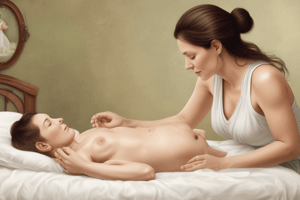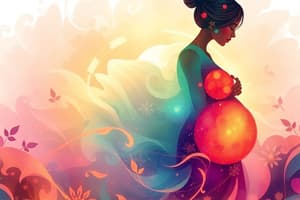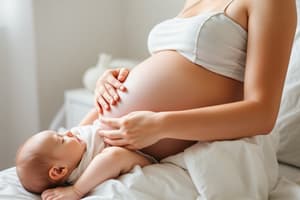Podcast
Questions and Answers
How long does a pregnancy last?
How long does a pregnancy last?
Approximately 40 weeks.
What might happen at start of birth?
What might happen at start of birth?
The mother gets contractions and/or the amniotic sac bursts.
What are labor contractions?
What are labor contractions?
Contractions of the uterus.
In how many phases does the birth of the child take place?
In how many phases does the birth of the child take place?
What must happen to the cervix so the baby can pass through?
What must happen to the cervix so the baby can pass through?
What can the mother do during the cervix phase?
What can the mother do during the cervix phase?
What is the second phase of labor?
What is the second phase of labor?
What happens during the expulsion phase if the amniotic sac hasn't burst yet?
What happens during the expulsion phase if the amniotic sac hasn't burst yet?
Which part of the baby comes out first?
Which part of the baby comes out first?
Who helps when the baby reaches the vaginal entrance?
Who helps when the baby reaches the vaginal entrance?
What happens to the umbilical cord after the baby is born?
What happens to the umbilical cord after the baby is born?
What is the third phase of labor called?
What is the third phase of labor called?
What is a newborn called after it is born?
What is a newborn called after it is born?
How big is a newborn?
How big is a newborn?
What does breast milk contain?
What does breast milk contain?
_____ surrounds the embryo and is filled with amniotic fluid.
_____ surrounds the embryo and is filled with amniotic fluid.
_____ is the contraction of muscles.
_____ is the contraction of muscles.
Flashcards
Gestation Period
Gestation Period
The period of approximately 40 weeks during which a baby develops in the mother's womb.
Labor Contractions
Labor Contractions
Contractions of the uterus that occur during childbirth, causing pain.
Amniotic Sac
Amniotic Sac
The fluid-filled sac surrounding the baby in the womb, which ruptures as a sign of labor.
Dilation Phase
Dilation Phase
Signup and view all the flashcards
Expulsion Phase
Expulsion Phase
Signup and view all the flashcards
Umbilical cord separation
Umbilical cord separation
Signup and view all the flashcards
Placental Phase
Placental Phase
Signup and view all the flashcards
Breastfeeding
Breastfeeding
Signup and view all the flashcards
Breast milk contents
Breast milk contents
Signup and view all the flashcards
Midwives
Midwives
Signup and view all the flashcards
Study Notes
- Pregnancy lasts about 40 weeks
- During this time the baby fully develops and is ready to be born.
- Childbirth begins when the mother experiences intensified labor and/or the amniotic sac bursts, releasing amniotic fluid.
- Labor pains are contractions of the uterus associated with pain.
- Childbirth occurs in three phases
Opening Phase
- This phase usually lasts the longest.
- The fully closed cervix must open to about 10 cm.
- This enables the baby's head to pass through.
- The head is the largest part of the baby's body.
- The mother cannot assist during this phase.
- The mother must remain calm and try to relax.
Expulsion Phase
- This phase begins when the cervix is open enough.
- The mother starts to push the baby through the vagina.
- The mother now experiences pushing contractions
- If the amniotic sac has not burst, it will burst now and the amniotic fluid will be released.
- Babies usually come into the world head first.
- Once the baby reaches the vaginal opening, the doctor or midwife helps by supporting the head first and then the entire baby
Afterbirth Phase
- After the baby is born, the connection between mother and baby is severed
- The umbilical cord is clamped first and then cut through
- It is also called "Abnabeln"
- Therefore, childbirth is also called "Entbindung"
- About half an hour after the baby's birth, the woman experiences some short, weaker contractions.
- During this time, the rest of the umbilical cord and the placenta are expelled
- This is called the afterbirth.
The Baby After Birth
- A newborn is about 50 cm tall and weighs 3 kg to 4 kg.
- The baby is usually breastfed with breast milk from the mother's breast.
- This process is called breastfeeding or "Stillen"
- Breast milk contains nutrients, minerals, vitamins, and antibodies against pathogens.
- Breast milk provides a baby with everything it needs during the first few months of life.
Studying That Suits You
Use AI to generate personalized quizzes and flashcards to suit your learning preferences.




